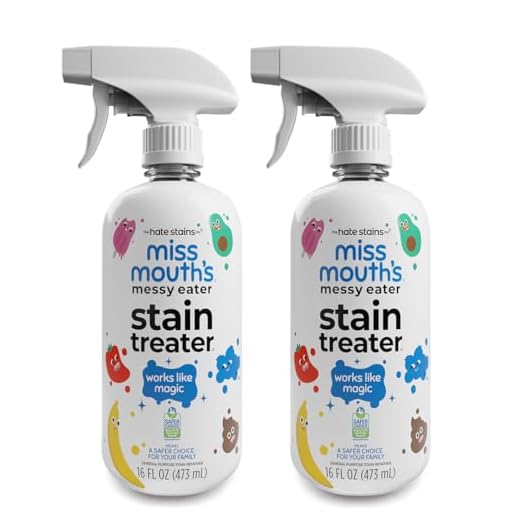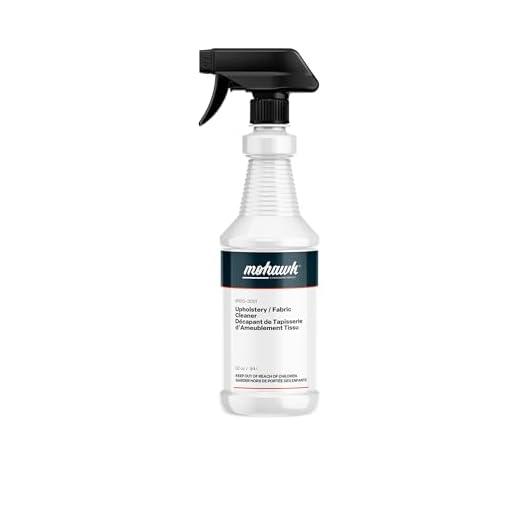



Act quickly with cold water; blot the affected area immediately to absorb as much liquid as possible. Using a clean cloth, gently dab without rubbing, as this can cause the pigment to spread deeper into the fabric.
Next, create a mixture of dish soap and hydrogen peroxide in equal parts. Apply it directly to the mark and let it sit for a few minutes. Blot again with a fresh cloth, rinsing it frequently to avoid reapplying the pigment.
If the discoloration persists, consider using a specialized upholstery cleaner or a solution of white vinegar and baking soda. Sprinkle the baking soda on the area, then spray the vinegar over it. Allow the mixture to fizz and penetrate for several minutes before blotting it away with a damp cloth.
Always test any cleaning solution on an inconspicuous spot first to ensure it won’t damage the fabric. Following these steps can help restore your furniture and keep it looking pristine.
Effective Techniques for Treating Beverage Marks on Upholstery
Act quickly with a clean, dry cloth to blot the affected area without rubbing, which can spread the liquid further. Next, sprinkle baking soda generously over the mark to absorb moisture. Allow it to sit for about 15 minutes before vacuuming it up.
If the blemish persists, mix one part dish soap with two parts hydrogen peroxide. Apply this solution to the spot using a soft cloth, gently dabbing the area. Rinse with water and blot dry to avoid over-saturation.
For stubborn marks, a paste made from baking soda and water can be effective. Apply it to the area, let it dry completely, and then vacuum. This helps lift any remaining residue.
Always test any solution on an inconspicuous section of the fabric first to ensure it does not cause discoloration. After treatment, ensure the area is thoroughly dried to prevent mold and odors.
Act Quickly: The Importance of Immediate Action
Addressing the issue swiftly can make a significant difference in the outcome. The sooner you attend to a spillage, the better your chances of minimizing damage. I recommend starting with a clean, absorbent cloth to blot the affected area immediately. This action is crucial to prevent the liquid from seeping deeper into the fabric, which can lead to a more challenging cleanup process.
Steps to Take Right Away
First, avoid rubbing the area; this can spread the liquid and worsen the situation. Blotting gently helps to lift the excess moisture. After that, consider using a mixture of cold water and mild detergent to treat the spot. Apply a small amount to a clean cloth and dab at the area, avoiding saturation that may lead to water damage.
Long-Term Benefits
Taking immediate steps not only improves the chances of complete restoration but also saves time and potential costs associated with professional cleaning services. The quicker you act, the less likely the discoloration will become a permanent fixture on your upholstery.
Gather Necessary Supplies for Stain Removal
Prepare the following items for effective cleanup: a clean, absorbent cloth or paper towels, which will help soak up the liquid without spreading it. You’ll also need club soda or sparkling water, as the carbonation can lift the pigment from the fabric. An appropriate cleaning solution is crucial; consider a mix of mild dish soap and white vinegar. For more stubborn marks, a stain remover designed for upholstery may be beneficial.
Additionally, have a soft-bristled brush on hand to gently work the solution into the fabric fibers. A spray bottle will help apply liquids evenly. Finally, keep a bowl of warm water nearby for rinsing the cloth after blotting.
Blotting Technique: How to Properly Blot a Stain
Begin the blotting process immediately. Use a clean, dry cloth or paper towel to absorb the liquid. Gently press the cloth onto the affected area without rubbing, as this can push the pigment deeper into the fabric.
Follow these steps for optimal results:
- Use a white cloth or paper towel to avoid transferring any color onto the fabric.
- Apply gentle pressure and blot the area repeatedly, moving to a clean section of the cloth as it becomes saturated.
- Continue blotting until no more liquid is being absorbed.
- If necessary, dampen the cloth slightly with cold water to help lift more residue, but avoid soaking the area.
Avoid scrubbing or circular motions, as these can damage the fibers and spread the liquid further. The key is to lift rather than smear.
After blotting, allow the area to air dry completely. Inspect the fabric to determine if further treatment is needed. If any marks remain, consider using a specialized cleaner suitable for the material.
Homemade Solutions: Utilizing Common Household Items
For effective treatment of spills, consider using items readily available in your pantry. Baking soda serves as an excellent absorbent. Sprinkle it directly onto the affected area, allowing it to sit for about 15 minutes before vacuuming it up. This can help lift residual marks.
White vinegar combined with dish soap creates a powerful cleaning solution. Mix one cup of white vinegar, one cup of water, and a tablespoon of dish soap in a spray bottle. Gently apply the mixture to the area, blotting it with a clean cloth until the discoloration fades.
Other Household Remedies
Another option is club soda, which can neutralize pigments due to its carbonation. Pour a small amount onto the spot and blot with a cloth. The bubbles help lift the color without damaging the fabric.
If you have cornstarch, it can also be beneficial. Make a paste with water and apply it to the mark. Allow it to dry completely, then brush it off. This method works well on many types of upholstery.
| Household Item | Usage |
|---|---|
| Baking Soda | Sprinkle on, let sit, and vacuum. |
| White Vinegar | Mix with water and dish soap, spray, and blot. |
| Club Soda | Pour on and blot with a cloth. |
| Cornstarch | Create a paste, apply, let dry, and brush off. |
For a delightful recipe to complement your cleaning efforts, check out how to cook a 9lb turkey breast in the oven. It’s sure to impress your guests while you tackle those pesky spills!
Commercial Stain Removers: Choosing the Right Product
Opt for enzymatic cleaners specifically designed for protein-based blemishes. These products break down the organic compounds in the discoloration, ensuring a deeper clean.
Evaluate options based on the following criteria:
- Surface Compatibility: Confirm that the formula is safe for your upholstery material to avoid any damage.
- Speed of Action: Select formulas that promise quick results to minimize the time the blemish remains.
- Odor Neutralization: Some products not only clean but also eliminate unpleasant smells, enhancing your living space.
- Eco-Friendly Options: Consider environmentally safe solutions that are free from harsh chemicals, ensuring a healthier home.
Check reviews and product ratings to gauge effectiveness and user satisfaction. Look for stain removers with a proven track record in tackling similar issues.
Before using any product, always conduct a spot test on an inconspicuous area to prevent unexpected discoloration or damage. Following these guidelines will help in selecting an effective solution for tackling those stubborn blemishes.
Testing on Fabric: Ensuring No Damage to Your Sofa
Before applying any cleaning solution, conduct a patch test on an inconspicuous area of the upholstery. This step is crucial to verify that the fabric can withstand the treatment without discoloration or damage.
Use a cotton swab or a soft cloth to apply a small amount of the chosen cleaning agent. Wait for a few minutes, then gently blot the area with a clean, dry cloth. Inspect for any adverse reactions such as fading or texture changes.
It’s advisable to test solutions like vinegar, baking soda, or commercial products specifically designed for fabric cleaning. Different materials react uniquely; for example, silk and velvet require extra caution, while synthetic fibers tend to be more resilient.
If the fabric passes the patch test without any issues, proceed with the cleaning process. Always follow the manufacturer’s guidelines regarding care and maintenance to ensure the longevity of your furniture.
In cases where the fabric shows damage during testing, consider seeking professional assistance. Experts have access to specialized equipment and solutions tailored for various materials, ensuring safe and effective treatment.
Post-Cleaning Care: Tips for Preventing Future Stains
Regularly applying a fabric protector can significantly reduce the likelihood of discoloration. Look for a product specifically designed for your upholstery type and follow the manufacturer’s instructions for application.
Establish a No-Drink Zone
Designate specific areas in your living space where beverages are allowed. This proactive approach minimizes the chances of accidental spills on your furniture.
Routine Maintenance
Implement a cleaning schedule to maintain the appearance of your upholstery. Vacuuming frequently and using a soft brush can help lift dirt and debris, preventing them from settling into the fabric and causing potential discoloration.
Be mindful of any new products you introduce to your environment, as they could alter the fabric’s resistance to spills. Always test any cleaning agents on an inconspicuous area before full application.
FAQ:
What is the best immediate action to take when a red wine stain is spilled on a sofa?
The first thing to do is to act quickly. As soon as the spill occurs, grab a clean cloth or paper towel and gently blot the stain. Avoid rubbing, as this can push the wine deeper into the fabric. After blotting, sprinkle some salt or baking soda on the stain. These substances can help absorb the wine. Let it sit for about 10-15 minutes, then vacuum it up. This initial step can prevent the stain from setting in.
Can I use household products to remove red wine stains from my sofa, and if so, which ones are effective?
Yes, several household products can be effective in removing red wine stains. One common solution is a mixture of dish soap and hydrogen peroxide. Combine two parts hydrogen peroxide with one part dish soap and apply it to the stain. Gently scrub with a soft cloth or sponge. Rinse with water afterward. Another option is to mix white vinegar and water in equal parts and apply it to the stain, then blot it with a clean cloth. Both methods can be quite effective on most fabrics.
Are there any specific cleaning methods to avoid when treating red wine stains on a sofa?
Yes, there are certain methods that should be avoided to prevent further damage. Avoid using hot water, as it can set the stain, making it harder to remove. Additionally, do not use bleach or ammonia-based cleaners, as these can damage the fabric and may cause discoloration. Rubbing the stain vigorously can also spread it, making it larger and more difficult to treat. Instead, always blot gently and use mild cleaning solutions that are safe for your specific sofa material.








